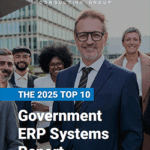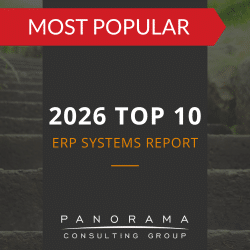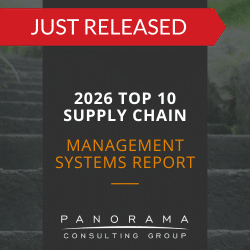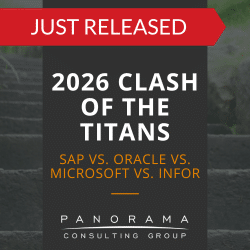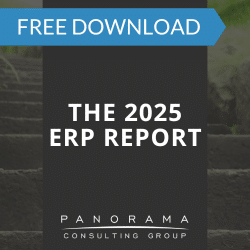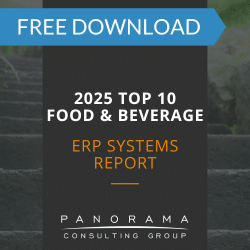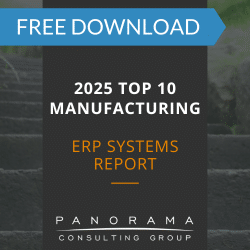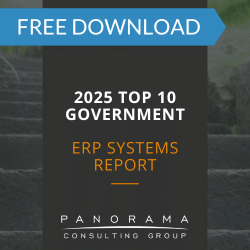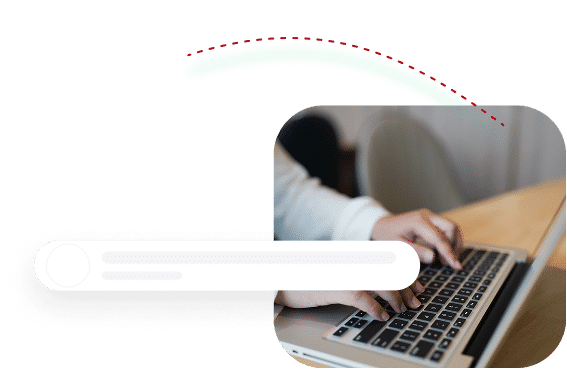- Common ERP quick win examples include early reporting pilots and simplified manual processes.
- Low-risk ERP improvements help teams show progress early without introducing rework or architectural debt later in the project.
- Knowing how to build momentum in digital transformation means using small victories to engage users, validate assumptions, and energize leadership.
- Tackling low-hanging fruit in ERP projects can strengthen stakeholder buy-in, reduce fatigue, and keep implementation on track through complex phases.
Even well-managed ERP implementations can begin to feel like an endless series of compromises, delays, and competing priorities.
The key to sustaining momentum? Delivering ERP quick wins that signal progress and build enthusiasm for the harder stages ahead.
Today, we’re sharing how low-risk ERP improvements and low-hanging fruit in ERP projects can extend your team’s stamina and sharpen your implementation strategy.
2026 Clash of the Titans
SAP, Oracle, Microsoft, and Infor each have a variety of systems that can support data-driven decision-making. We surveyed customers of these four vendors to find out what their selection and implementation process was like.
The Real Definition of an ERP Quick Win
ERP quick wins are short-term gains that can validate system architecture, test change management assumptions, and surface unexpected risks while they’re still manageable.
Most importantly, they create visible, practical value that keeps stakeholders engaged during complex phases of implementation.
Too often, though, quick wins are confused with shortcuts. Executives ask for an early “win” and get a dashboard prototype or a mock interface that’s decoupled from actual business processes. The team feels the hollowness of the gesture—and momentum slips further.
The difference between a cosmetic milestone and a meaningful quick win lies in its integration with people, processes, and data. In other words, a win only counts if it simplifies work, strengthens a key process, or clarifies decision rights.
ERP Quick Win Examples
1. Deploying Early Reporting Use Cases Using Cleansed Data
Instead of waiting until all modules are live, use your data cleansing efforts to deploy early business intelligence dashboards in parallel.
For example, a manufacturer implementing a supply chain management system might use reconciled inventory data to create a temporary stock visibility report—even if the full inventory management module is months away.
This would provide early value to functional teams, while giving the company the opportunity to assess data quality and the team’s ability to act on data insights.
Ultimately, this keeps the project visible, reinforcing a sense of progress and sustaining engagement during the slower phases of implementation.
2. Simplifying a High-Visibility Manual Process Before Full Automation
Rather than over-engineering automations from day one, target a painful but contained manual process—such as time entry approvals, petty cash reconciliation, or basic customer service case logging.
Use minimal system configuration to streamline the process, and then solicit user feedback.
Even if this mini-solution is retired post-go-live, the early credibility earned with users and the momentum gained from demonstrating tangible improvement is worth it.
3. Piloting Role-Based Permissions in One Department
One of the most overlooked quick wins is piloting user roles in a single business unit.
Permissions, if not tested early, often become a fire drill late in the project. Giving one department a preview of the new security model serves multiple purposes:
- Validating the permissions framework
- Building peer advocacy for the new system
- Creating change champions who can coach others
- Allowing the project team to recover from burnout by celebrating a small, manageable milestone
4. Conducting Targeted “Pre-Go-Live” Training for a Single Workflow
Pick one high-frequency, low-complexity process—like processing a return or entering a new vendor—and train a select group of users months ahead of other users.
Monitor how well they retain the information and what questions arise. Then, use those insights to adjust your training approach so users are better prepared and the project keeps moving forward without delays caused by confusion or rework.
5. Using the ERP System to Drive a Real-Time Business Decision
One of the best ways to create visible traction is to connect ERP configuration to a real-world decision-making need.
For instance, if you’re designing a manufacturing ERP system to enable SKU rationalization or new pricing rules, you can use mock data and sandbox testing to simulate real-world outcomes and inform leadership decisions in the present.
This allows executives to validate or revise their assumptions using the ERP platform itself. In this way, your quick win becomes a catalyst for executive engagement, as leadership sees the ERP effort not as a cost center, but as a tool already shaping smarter decisions.
Best Practices for Building Momentum With Quick Wins
Quick wins, by their nature, are enticing. They offer the illusion of acceleration. However, leaders must be careful: misused, they can create architectural debt, distract teams from foundational work, and reinforce old behaviors you’re trying to change.
What separates a high-impact win from a short-term distraction is how well it aligns with long-term strategic objectives and organizational readiness.
Here are five principles to guide your approach to low-risk ERP improvements:
1. Design Each Quick Win to Strengthen a Business Capability
A quick win should be deliberately linked to an overall operational capability that you’re trying to improve, whether that’s better data governance or stronger cross-functional workflows.
Our enterprise software consultants often tell clients that every quick win should help define how future processes will work, who will be responsible for them, and how data will be managed and used. This ensures that each win builds the foundation needed to keep the project moving forward.
2. Test Change Readiness—Not Just Technical Readiness
Every quick win should also be designed to observe how the organization reacts to change: Who resists it? Who adapts quickly? Who becomes a vocal advocate?
These insights are as valuable as the functional gain itself, and can be used to target communication where it’s needed most—preventing resistance from stalling progress.
3. Avoid the “Shadow Stack” Trap
A common pitfall is solving problems with one-off tools that won’t survive the ERP cutover.
For example, implementing a standalone workflow app to solve a routing issue may help in the short term, but creates rework—and confusion—later.
Our ERP consultants always tell clients to stick to solutions that either preview ERP functionality or use infrastructure that will persist post-go-live. This keeps the project moving in a clear, forward direction, avoiding detours that drain energy and disrupt the large-scale transformation.
4. Frame Quick Wins as Experiments, Not Endpoints
Communicate that each quick win is a prototype, not a permanent state. This framing helps manage expectations across the organization: users don’t expect perfection, leaders don’t expect full ROI, and project teams don’t feel pressured to “get it right the first time.”
ERP initiatives that treat every deliverable as final tend to get stuck when conditions change. But those that build agility into their DNA are better equipped to adapt, evolve, and sustain momentum through uncertainty.
5. Use Wins to Reinvigorate Executive Sponsorship
In large-scale ERP initiatives, sustained momentum depends on executive energy.
Too often, executive sponsors become passive once funding is approved. If they can point to a win that resonates with their peers, they’re more likely to stay active and vocal.
A well-communicated quick win gives senior leaders something tangible to champion. When this sponsorship is visible and aligned with real outcomes, it sends a signal to the rest of the organization: the project is delivering value and continued engagement is worthwhile.
Learn How to Build Momentum in Digital Transformation
Quick wins reconnect your people to the promise of transformation in ways that feel immediate and real.
If your ERP project is stalling—or if you’re looking for ways to reinvigorate your team mid-implementation—start by identifying the right quick win. We can help. Our independent ERP consultants have helped organizations across industries turn early wins into lasting momentum. Contact us below to get connected with an expert in your industry.


